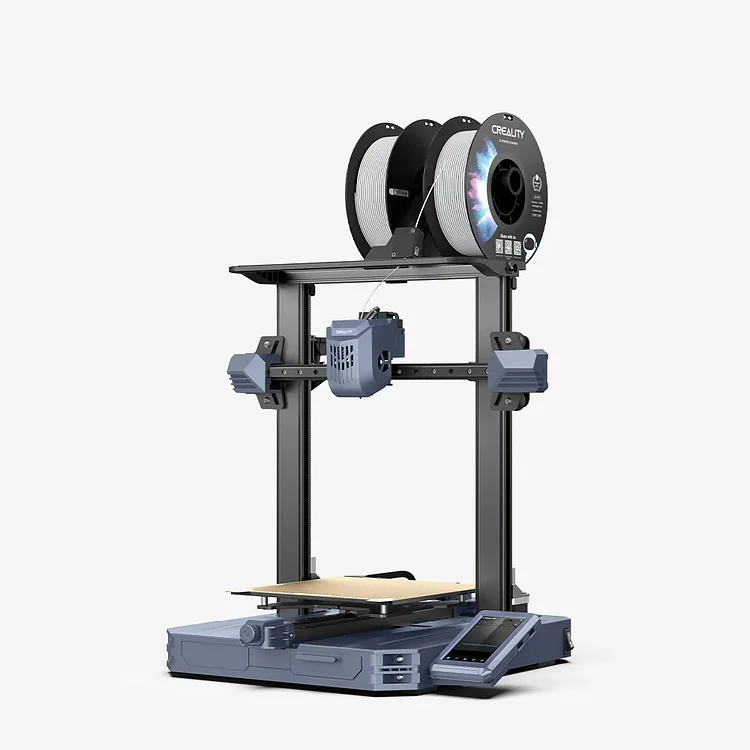Compare CR10 SE vs K1 Max
Comparison between the best 3D printers
Choose the best 3D printer at the best price. The cheapest 3D printers are here.
Buy a 3D printer here with 3D Fila.
 |
 |
|
| Model | CR10 SE |
K1 Max[BUY K1 Max] |
| Printing Material | Filament | Filament |
| Buy Filament for Creality CR10 SE | Buy Filament forCreality 3D K1 Max | |
| Estimated price | $386,00 | $1300,00 |
| Manufacturer | Creality | Creality 3D |
| Release Year | 2023 | 2023 |
| Print Volume [mm] | 220x220x265 | 300x300x300 |
| Printer Size [mm] | 490x470x625 | 435x462x526 |
| Weight [kg] | 6,9 | 18 |
| Power Loss Recovery | NO | YES |
| Enclosed printer | NO | YES |
| Bed Leveling | Automatic | |
| Filament End Sensor | NO | YES |
| Bed type | Heated | |
| Power supply system | Direct Drive | Direct Drive |
| Standard nozzle | 0,4 | 0,4 |
| Maximum Nozzle Temperature [°C] | 300 | 300 |
| Maximum Bed Temperature [°C] | 110 | 100 |
| Maximum printing speed [mm/s] | 600 | 600 |
| Filament holder | YES | YES |
| Camera for supervision | YES | YES |
| Recommended filaments | PLA, PETG, PET, TPU, PA Wood, ABS, ASA, PA, PLA-CF | ABS, PLA, PETG, TPU, PA, ASA, PC, PLA-CF, PA-CF, PET-CF |
| Recommended slicers | Creality Print, Cura, Simplify3D, PrusaSlicer, Orca Slice | Creality Print, Cura, Simplify, Slic3r, IdeaMaker e outros |
| Maximum Resolution [mm] | 0,1 | 0,1 |
| Processor | ||
| Display | Display touchscreen 4,3'' | |
| Power Supply | ||
| Connectivity | USB, Wifi | USB / Wi-Fi / Ethernet |
| Operating systems | Windows, Linux, Macbook | Windows, Mac, Linux |
| Date of registration in the system | 2024-07-02 | 2023-12-01 |
| Release date | 2023 | 2023 |
| Extra features | The Creality CR10 SE stands out for its printing speed of up to 600 mm/s, easy and intuitive assembly, direct extruder with double gears, hotend with hardened steel nozzle and ceramic heater, automatic leveling with CR-Touch and pressure sensor, and use of Creality OS firmware based on Klipper, with automatic input shaping calibration. It also includes Wi-Fi connectivity, a filament out-of-stock sensor and a robust structure with linear rails on the X and Y axes. | The Creality K1 Max stands out as a fast Core XY 3D printer with a large build volume of 300 x 300 x 300 mm. It is fully enclosed and equipped with AI sensors to prevent print failures. This model has a smooth and flexible PEI build platform, and uses an automatic leveling system with LIDAR, as well as a filament run-out sensor. LAN, Creality Cloud and USB Flash Disk connectivity are available, as well as a 4.3-inch touchscreen interface. The K1 Max is robust, weighing in at 18 kg, and includes an AI camera and limited version of the Klipper firmware. Its motion system is solid and the printer is efficient with high-temperature filaments, but it is not silent. Assembly is 99% complete, requiring only minor adjustments before use. |
| Support for multiple colors and materials (AMS and CFS) | NO | NO |
Notes * |
||
| Cost-benefit | 7 / 10 | 7 / 10 |
| Hardware | 2.1 / 10 | 4.2 / 10 |
| Tela | . | . |
| Print volume | 3 / 10 | 4 / 10 |
| Performance | 5 / 10 | 5 / 10 |
| [BUY K1 Max] |
Conclusion |
| In comparing the Creality CR10 SE and the Creality K1 Max 3D printers, it’s clear that both models have their strengths and weaknesses, catering to different user needs and preferences. **Affordability and Value:** The CR10 SE is more budget-friendly, making it an attractive option for hobbyists or those new to 3D printing. It offers essential features like automatic leveling and a decent print speed, providing good value for its price point. The K1 Max, although significantly more expensive, justifies its higher cost with advanced features and a larger print volume, appealing to professionals or serious enthusiasts who require greater capabilities and reliability in their prints. **Print Volume and Capabilities:** With a print volume of 300 x 300 x 300 mm, the K1 Max accommodates larger projects, while the CR10 SE offers a more modest volume of 220 x 220 x 265 mm, making it suitable for smaller prints. The enclosed design of the K1 Max provides better temperature control, essential for specific materials, thus enhancing print quality and minimizing warping. **Technology and Features:** The K1 Max is equipped with a series of high-tech features, including AI sensors and a LIDAR-based leveling system, which significantly enhances print reliability and success rates. The presence of a filament run-out sensor and power loss recovery further supports uninterrupted printing, a crucial aspect for lengthy projects. In comparison, the CR10 SE lacks some of these advanced functions but still provides a solid performance for users who don’t require them. **Usability and Ease of Use:** Both printers offer good connectivity options, but the K1 Max's robust interface and almost fully assembled state make it more user-friendly right out of the box. On the other hand, the CR10 SE’s simpler setup might appeal to those who enjoy a hands-on approach to their equipment. In conclusion, the choice between the CR10 SE and the K1 Max fundamentally comes down to specific needs and budget constraints. For users seeking a cost-effective solution with solid performance for smaller prints, the CR10 SE is an excellent option. Meanwhile, those who prioritize advanced technologies, larger print volumes, and greater reliability are likely to find the K1 Max worth the investment. |

